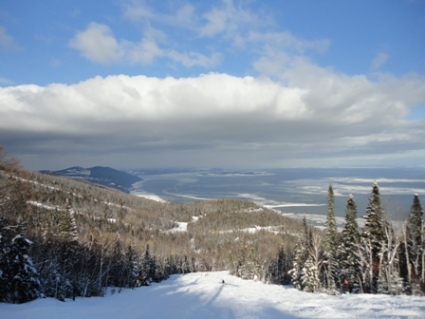The first time I went skiing, which was two years ago, I was terrified. I was still terrified when I hit the slopes for the third time ever a couple of weeks ago; this fear, however, had less to do with wiping out in the woods (which I did a good eight times or so) than it did with the frozen river in view. The thick ice floes I could see being carried upstream were miles away, but the clarity of their image made me feel as if I’d be taking an impromptu dip if I made even one misstep.

The slopes of Le Massif offer astounding views.
Photo © Sacha Jackson.
This trip, I visited during spring break with two old ski pros, and the station was packed with families, flashy teens with snowboards, and agile four-year-olds who whizzed past me repeatedly throughout the day. The light snow that greeted us soon turned into a snowstorm. The hills couldn’t have been more picturesque, and though the snow made for difficult skiing, it was perfect for falling.
Since I’m such a beginner, I got a little help from one of the mountain’s guides, Denis, who introduced himself by telling me that he’s been skiing for fifty years. I couldn’t have asked for a nicer guy to show me the easiest route down the mountain. My favorite part of the day was when he took me on a run through a heavily wooded area; the rest of Le Massif was full of experts swooshing down the mountain, but this little trail, L’Echouage, was peaceful and picturesque, and it reminded me of all the reasons I love winter.
Le Massif has fifty-three runs to choose from, not including the beginner’s area or the huge off-trail section that lets experienced skiers take to the woods. All of the runs, however, get you to the bottom of the mountain—where I couldn’t help but notice that the river really is quite a ways away. Once at the bottom, I took a little time out for a hot chocolate at the chalet before hopping on a chairlift back up to the top.
Massif means “mountainous region” in French, but it’s convenient that it sounds like “massive” to the English ear—because it is. Altitude-wise, it’s a little over 2,700 feet—the highest vertical east of the Rockies—but the pristine surroundings and the views of the river are what make it an imposing figure. To get there, we took the provincial highway, a two-lane road that follows alongside the river before it heads into the mountains. The closest town to the mountain is Baie-St-Paul, which is about twenty kilometers down the road, and on the way there you spend a good portion of the drive realizing just how quaint this region is. Its rural atmosphere helps to give the station a certain charm.
Over the past couple of years there have been a few changes to the mountain—a gondola was installed in 2011, and there’s now a scenic train ride that you can take from Québec City to the mountain’s base for a couple hundred dollars—and a few more are on the way. So far, though, they’ve managed to modernize Le Massif without taking away from its natural beauty. As I continued skiing (and not falling) that day, I couldn’t help but think—and hope—that no matter the development that occurs there, the mountain will always have that relatively untouched feel that makes it unique.